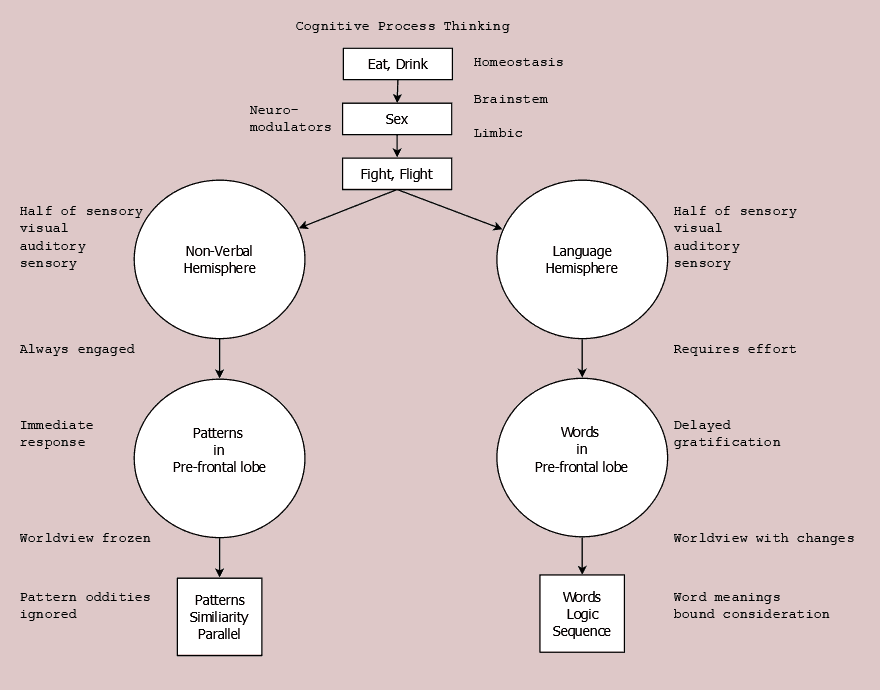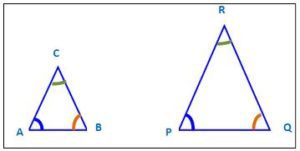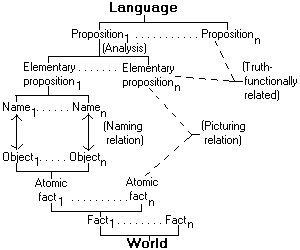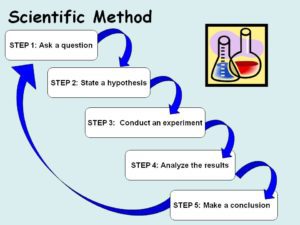Mentalese is a term for the collection of ideas which attempt to describe our thoughts and internal monologues. What symbols do we use for thinking and what rules do they follow?. The symbols are so often words that sometimes it seems that all thought is words. The ready but naive assumption that all thoughts are monologues which follow the rules of language fails, as in cases when we can’t express what we mean. When one plays sports, are all the athlete’s thoughts in words? When you are fully engaged in your favorite activity, are all your thoughts expressed in sentences? Perhaps for some, but many other will answer no.
Even when one thinks in words, the flow is often not logical, but associative. You don’t deduce your next thought. You’re reminded of a related incident or person upon which you reflect. Perhaps with both logic and associativity for satisfying your current needs, desires, goals, or concerns.
Steven Pinker’s position on mentalese in The Language Instinct is that mentalese is a species-wide, innate function that is unaffected by the process of learning a language. That seems a gratuitous assumption, with an unwarranted restriction. Although I don’t agree with the strong Sapir-Whorf hypothesis, I do agree with the weak Sapir-Whorf, that one’s internal worldview is affected by the words one has to describe it. In fact, I extend the restriction further including non-verbal concepts (or patterns). Thus, if your parents never showed reciprocal kindness when you were in the critical stage of learning kinship relations, your wordview is skewed in that dimension. Although you have learned the words for describing how to act in such relationships, the structure of your learned internal worldview do not have such a structure.Dual Modes

Mentalese has dual modes of operation. The mind thinks via two parallel and simultaneous streams, one of which relies on abbreviated language augmented with logic. The other uses patterns arranged by associations. The pop culture meme of two brains acting independently, the right brain with intuition and the left with words ignores the periodic comparison across the corpus callosum as the two streams of perceptions arise from sensory experience with a strong amalgamation from memory. These processes are summarized in the Figure 1, Cognitive process thinking.
Also the Almost Gate function gives a useful explanation of intuition arising from patterns, association, and similarity.
Association Thought Stream
Since language (linguistic symbols) has been the default approach to mentalese, let me start with association based on similarity.
Initial sensory perception—whether visual, aural, tactile, taste, or odor—does not require words. It takes a number of steps into the visual recognition path before words can be attached to a clump of visual points. As is well known, though it can be easily overlooked, words do not exist for every physical feature. A classic example is that no one, but a rare physician, would know the name for the two lines with a downward curve between them that rests under the nose of almost every person.
“So what?” you might ask. The importance is that, in a person’s decision-making about any comment or behavioral response involving that feature, the pattern of the physical feature, rather than a word, is used for consideration.
Two patterns, perhaps one from immediate sensation and the other from memory, both of which surmount the Almost Gate, fire the same neurons downstream. They cause similar neural activity and are thus treated as the same.
Language Thought Stream
Our language has a name for many, many important categories, not that anyone of us knows all of them or relies on that knowledge when thinking. Language is a given categorization of phenomena. Think of it—we are given categories to arrange our experiences by. It’s a gift of our language’s progenitors, which relieves us of the burden of discovering relationships and differences between phenomena, and thereupon apply our logic to them.
When we think without need to communicate to others, we do not need to bother with much of the mechanism of language that is for interpersonal communication. For example, the point of view is ours without the need for a statement or consumption of mental capacity. Another difference is that additional verbiage that would be necessary to make our idea clear and not misleading to others does not need to exist in our personal ruminations. That frees more working memory for additional content, broadening our perspective.
Logic is not independent of language. Sure, one can take logic courses in college, but we all have access to folk logic, the logic built into our language. We have if, then, no, never, and always. For the more sophisticated thinker, language provides gradations of likely and chance to use in our ratiocination. However, most logic occurs automatically. Although we can verbalize it after-the-fact, it happens without our conscious calculation.
Interaction at the Concept Elevator
The Concept Elevator is my term for the numerous transitions that both verbal depictions and patterns go through with increasing abstraction (loss of detail) on their journey from sensory reception to decision-making. With the corpus callosum allowing each cortical hemisphere to compare its result with that reached by the other side, there are many times when one stream can affect the other. Since there are about 100 steps from perception to reaction, there are that many stops for the concept elevator.
Why Do We Have Two Streams of Thought
Why do humans have two streams of thought?
Similarity
The first reason is that all animals use the neural threshold and the Almost Gate. So, association is the base mode, but it has flaws. Treating similar patterns as if they are identical can give rise to errors in decision-making. A convenient but terrible example is what we call jumping to conclusions.
Thus, somehow, a cultural process, not an evolutionary process, developed the use of words for commonplace objects and then onto actions and consequences, and abstractions. Our intellectual debt to the caveman Einsteins and savanna Curies of language is often overlooked, since it is the same humongous amount for every single person. However, for all of language’s power, two problems arise when we rely on it exclusively.
Language
First, language allows paradoxical statements, such as “I am lying.” If the person making this claim is lying, then his statement is false, implying that he is telling the truth, in which case the statement is true, yet it implies that he is lying. Self-referential statements are rife with illogical implications like the liar paradox. Any conclusion can be reached when there are paradoxes in the starting premises.
As debilitating as that could be despite our best efforts, an even worse problem is that logic is sterile. One can only deduce truths that are embedded in the starting premises. Thus, we are limited to conclusions ensconced in language that we can shake out.
Scientific Method
Before you make up your mind on that last statement, let me describe the solution proposed by the hypo-deductive method of science. A scientist posits a hypothesis, arrived at most mysteriously, a process that often occurs not in words but in associations of similar abstract patterns. That hypothesis becomes a premise added to the existing knowledge. The hypothesis and those from existing knowledge are logically examined for new consequences. An experiment is performed to see if the new conclusion is borne out.
By generating a non-logical hypothesis and applying logical deduction, scientists are able to expand the existing knowledge and discard erroneous hypotheses. A similar linking of tentative hypothesis and logical deduction underlies most of our thoughts, although we rarely worry about confirming our hypotheses. We usually dash to applying the results we find rather than second guess our conclusions.
It should be noted that confirming the consequence of a theory does not prove the hypothesis. It merely does not reject the hypothesis. Also be aware that in media coverage (your tertiary source of knowledge) a confirmed theory is usually called a proven theory.
Although philosophers and philosophers of science often lament that they don’t understand where hypotheses come from, they advance knowledge by logically melding new hypotheses onto the theories of their field.
Lest you think only scientists do this, let me just point to financial gurus. They use an analogous method. There is a body of knowledge about factors affecting stock prices. To that, stock market players add their personal hypotheses and additional ideas. Consider the different ways people viewed the 2007-2008 stock market meltdown, a replay of 1929 or not, and how that belief affected their actions.




In Helen Keller’s autobiography, which I’ve just read, she expresses the belief that thoughts being prior to language. The Story of My Life (p 96 in Large Print Thorndike Press edition) has this:
“It seems to me that the great difficulty of writing is to make the language of the educated mind express our confused ideas, half feelings, half thoughts, when we are little more than bundles of instinctive tendencies. Trying to write is very much like trying to put a Chinese puzzle together. We have a pattern in our mind which we wish to work out in words; but the words will not fit the spaces, or, if they do, they will not match the design.”